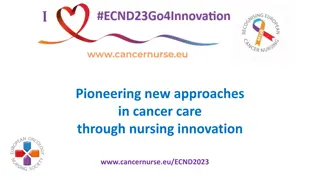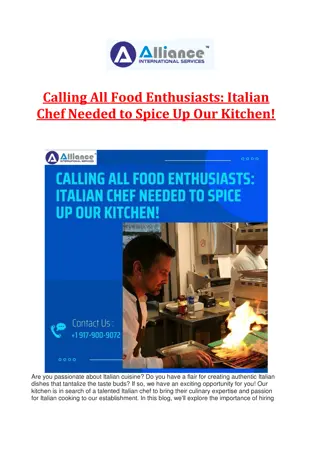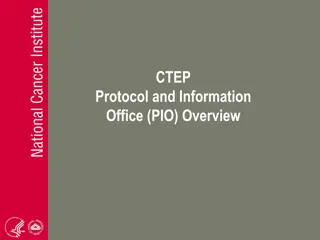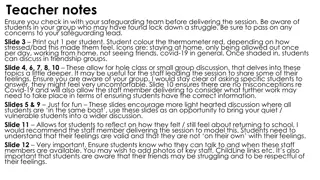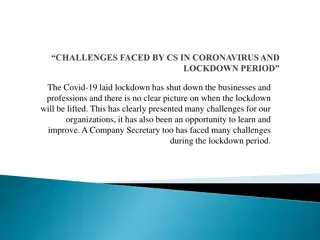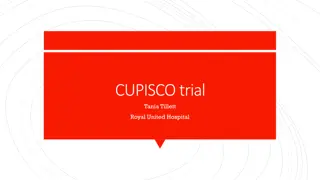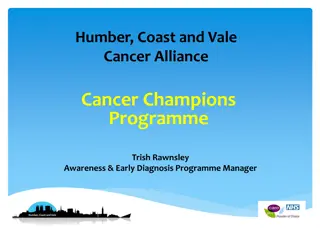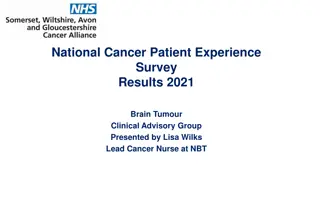Insights from Italian Lockdown on Cancer Patients' Perspectives
The Italian lockdown during the SARS-CoV-2 pandemic posed significant challenges for cancer patients, affecting their access to care and psychosocial well-being. A survey conducted by AIIAO shed light on the impact, behaviors, and perceptions of isolated cancer patients.
Download Presentation

Please find below an Image/Link to download the presentation.
The content on the website is provided AS IS for your information and personal use only. It may not be sold, licensed, or shared on other websites without obtaining consent from the author.If you encounter any issues during the download, it is possible that the publisher has removed the file from their server.
You are allowed to download the files provided on this website for personal or commercial use, subject to the condition that they are used lawfully. All files are the property of their respective owners.
The content on the website is provided AS IS for your information and personal use only. It may not be sold, licensed, or shared on other websites without obtaining consent from the author.
E N D
Presentation Transcript
MEETING SUMMARY ESMO 2020, VIRTUAL MEETING Paola Belardi, RN San Donato Hospital, Arezzo, Italy HIGHLIGHTS FROM GI NURSES CONNECT SEPTEMBER 2020 2
DISCLAIMER Please note: Views expressed within this presentation are the personal opinions of the author. They do not necessarily represent the views of the author s academic institution or the rest of the GI Nurses CONNECT group. This content is supported by an Independent Educational Grant from Bayer. Disclosures: Paola Belardi does not have any relevant financial disclosures 3
SARS-COV-2 AND THE PERSPECTIVES OF PEOPLE LIVING WITH CANCER: THE AIIAO SURVEY ON THE ITALIAN LOCKDOWN Biagioli V, et al. ESMO 2020. Abstract #CN29. Oral presentation AIIAO, Associazione Italiana degli Infermieri di Area Oncologica; SARS-CoV-2, severe acute respiratory syndrome coronavirus 2 4
BACKGROUND AND METHODS Background The Italian lockdown against SARS-CoV-2, which began on 9 March 2020, was particularly relevant to cancer patients, who were considered at higher risk of infection1 Patients faced the combined psychosocial burden of mass quarantine2and the challenges of receiving safe cancer care1 Methods3 The Italian Association of Cancer Nurses, AIIAO, conducted an online survey between 29 March and 3 May 2020 ( Phase One of the Italian COVID-19 emergency plan) Self-isolated people living with cancer were invited to complete the survey, which covered Socio-demographic and clinical characteristics Opinion on the impact of SARS-CoV-2 Access to cancer care Behavioural measures implemented Perception of being isolated (ISOLA scale, 1-5, in which 5 indicates greater effect or agreement)4 AIIAO, Associazione Italiana degli Infermieri di Area Oncologica; COVID-19, coronavirus disease 2019; SARS-CoV-2, severe acute respiratory syndrome coronavirus 2 1. Yu J, et al. JAMA Oncol. 2020;6:1108-10; 2. Casagrande M, et al. Sleep Med. 2020;75:12-20; 3. Biagioli V, et al. ESMO 2020. Abstract #CN29; 4. Biagioli V, et al. Eur J Cancer Care. 2019;28:e12955. 5
RESULTS The survey was completed by 195 adults living with cancer Female, 76%; mean age 50.3 11.2 years; and self isolating >4 weeks, 70.8% Figure 1: Infection control measures 120 96.3 95.2 100 81.5 Patients (%) 80 55.6 60 29 40 Haematological malignancy, 51.3% 20 0 Most respondents implemented infection control measures (Figure 1) Hand washing Social distancing Face mask Gloves Over-the-counter supplements Around half believed themselves to be at higher risk of SARS-CoV-2 infection (54%) or severe complications (51%) Figure 2: Frequency of hospital visits 3% No visits Most (62%) reported having reduced access or no access to cancer care (Figure 2) Reduced frequency 38% 35% Same frequency as usual 29% were afraid that their cancer was not under control Other 24% SARS-CoV-2, severe acute respiratory syndrome coronavirus 2 6 Biagioli V, et al. ESMO 2020. Abstract #CN29.
RESULTS AND CONCLUSIONS Figure 1: I believe because of my cancer, I will suffer from severe consequences in case of infection RESULTS Not at all 4.1 A little 21.5 Respondents had significant concerns about the effects of infection (Figure 1) Quite a bit 23.6 Very much 24.6 Isolation-related suffering was at high levels (Figure 2) Completely 26.2 Perceived suffering, on many measures, was greater than that of patients in hospital-based isolation for transplantation 0 5 10 15 20 25 30 Patients (%) Figure 2: Perception of isolation Greater social isolation was reported by older patients, those with a lower education level, and those living without children 3.31 3.5 3.14 Mean ISOLA score 3 2.64 2.5 2 1.5 CONCLUSIONS 1 0.5 Nurses should help prioritise patients cancer care and take on an increased support role through remote communication 0 Isolation-related suffering Problems with others Problems with self Biagioli V, et al. ESMO 2020. Abstract #CN29. 7
MANAGEMENT OF IMMUNOTHERAPY TOXICITIES: A NEW CHALLENGE Bascu ana Sanchez L, et al. ESMO 2020. Abstract #CN34. Oral presentation 8
BACKGROUND AND METHODS Background Immunotherapy is now a main treatment option for many tumours1 AEs differ from those of cytotoxic chemotherapy and are driven by immune-system activity1 As part of an interdisciplinary team expert nurses can provide specific care for the control and management of AE symptoms and provide thorough follow-up3 Methods3 Literature review: PubMed, CINAHL, Cochrane Library, JBI EBP database, and Scopus Key words: cancer treatment, immunotherapy, oncology, nursing care, immunotherapy-related adverse events, toxicities Results discussed by an interdisciplinary working group of oncologists, internists, and nurses AE, adverse event; CINAHL, Cumulated Index to Nursing and Allied Health Literature; JBI EBP, Joanna Briggs Institute s evidence-based practice 9 1. Jamal S, et al. J Rheumatol. 2020;47:166-75; 3. Bascu ana Sanchez L, et al. ESMO 2020. Abstract #CN34.
RESULTS The interdisciplinary team created an algorithm for each category of toxicity The algorithm can guide nurses in prescribing and management Support in grading the condition is followed by well defined management procedures supporting independent care by nurses, as appropriate Immune-related gastrointestinal toxicity Diarrhoea Frequency, consistency, aspect Complicated diarrhoea: grade 1 or 2 plus >1 warning sign (abdominal pain, nausea or vomiting, asthenia, fever, etc.) Uncomplicated diarrhoea: grade 1 or 2 Diarrhoeagrade 3 or 4 Grade 1: >4 bowel movements per day Mild increase in ostomy Grade 2: 4-6 bowel movements per day Moderate increase in ostomy Grade 3: >7 bowel movements per day Severe increase in ostomy Grade 4: perforation, bleeding, ischaemic necrosis, toxic megacolon Day unit/CAI/nurse visit AOS EMERGENCY DEPARTMENT Telephone re-evaluation after 24 hours Worsening or no improvement With improvement: stringent diet progression STOP loperamide after 24 hours without diarrhoea AOS, acute oncology service. 10 Bascu ana Sanchez L, et al. ESMO 2020. Abstract #CN34.
RESULTS The algorithms support nurse-led care of grade 1 or 2 toxicity Skin toxicity Rash maculopapular, rash acneiforme, dermatitis, xerosis, itching Grade 1 Grade 2 Grade 3 Grade 4 Rash over <10% of body surface with or without symptoms Rash over 10% to 30% of body surface with or without symptoms Rash over >30% of body surface with or without symptoms Rash over >30% of body surface with infection or other complication Nurse visit, day unit, or telephone solution Nurse visit or acute oncology service (AOS) Oncologist or referral to dermatologist Topical moisturising cream or ointment Oral or topical antihistamine for itching (if present) Topical corticosteroid cream (gentle action) Topical moisturising cream or ointment Oral or topical antihistamine for itching (if present) Topical corticosteroid cream (gentle action) Topical moisturising cream or ointment Oral or topical antihistamine for itching (if present) Topical corticosteroid cream (strong action) plus IV corticosteroid IV corticosteroid and immediate assessment by specialist STOP immunotherapy permanently Immunotherapy can continue Immunotherapy can continue STOP immunotherapy (may resume if symptoms reduce to grade 1 or mild grade 2) IV, intravenous 11 Bascu ana Sanchez L, et al. ESMO 2020. Abstract #CN34.
CONCLUSIONS Multidisciplinary action algorithms can improve the treatment approach at different stages of the oncological process Toxicity algorithms have the potential to Improve the assessment, detection, and treatment of toxicity according to defined criteria Optimise time and resources and improve quality of care, patient satisfaction, and safety Promote independent, nurse-led treatment and its value Bascu ana Sanchez L, et al. ESMO 2020. Abstract #CN34. 12
GENDER DIFFERENCES IN CANCER CARE Domenech-Climent N ESMO 2020. Abstract #CN47. Poster presentation 13
BACKGROUND AND METHODS Background Gender has an influence on epidemiology, gene expression, treatment response, side-effects, and even survival in some types of cancer1,2 Methods3 Literature search of English-language systematic reviews that included an analysis of gender differences This study was carried out using PubMed and Scopus and the following key words Gender bias, gender differences, gender roles, sex differences, and cancer or neoplasm 1. Dobruch J, et al. Eur Urol. 2016;69:300-10; 2. Kim S-E, et al. World J Gastroenterol. 2015;21:5167-75; 3. Domenech-Climent N. ESMO 2020. Abstract #CN47 14
RESULTS AND CONCLUSIONS RESULTS 24 articles analysed gender as a variable 9 considered sex hormones (Figure) Only 1 article took into account lifestyle and sociocultural factors (Figure) Fewer women than men were included in clinical trials Factors influencing gender differences in cancer CONCLUSIONS 10 9 Number of studies 8 7 There is a bias towards biological vs lifestyle or social drivers of gender differences 6 5 4 3 2 1 1 0 Gender bias remains an issue in clinical trial recruitment Hormonal factors Side-effects Risk factors Lifestyle Clinical trials Molecular and genetic mechanisms Domenech-ClimentN. ESMO 2020. Abstract #CN47. 15
REACH GI NURSES CONNECT VIA TWITTER, LINKEDIN, VIMEO & EMAIL OR VISIT THE GROUP S WEBSITE http://www.ginursesconnect.info Follow the Watch us on the GINURSES CONNECT Vimeo Channel Email Follow us on Twitter @ginursesconnect GINURSESCONNECT Group on LinkedIn antoine.lacombe @cor2ed.com 16
GI NURSES CONNECT Bodenackerstrasse 17 4103 Bottmingen SWITZERLAND Dr. Froukje Sosef MD +31 6 2324 3636 froukje.sosef@cor2ed.com Dr. Antoine Lacombe Pharm D, MBA +41 79 529 42 79 antoine.lacombe@cor2ed.com Heading to the heart of Independent Medical Education Since 2012



